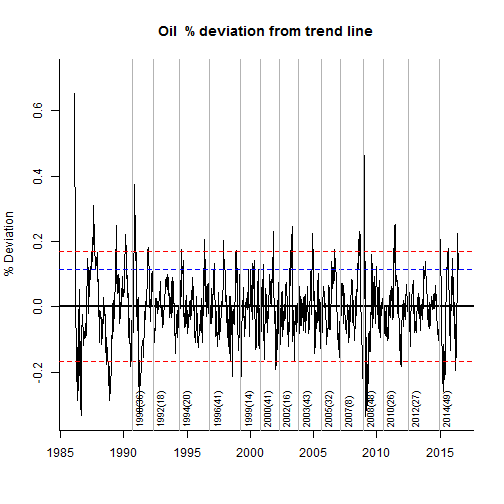The following report provides an update on some of the metrics I use to classify market risk. The word classify is more appropriate as I think that in essence you cannot forecast risk but rather attempt to adjust to it into a timely fashion. Clearly risk would not be a risk if you could forecast it accurately. However as there is generally some degree of persistence in risk regimes, using a dynamic classification may be a useful approach for portfolio rebalancing and hedging. In this report I use the CBOE Brazil ETF Volatility Index (VIX Brazil) as a measure of stock market risk for Brazil . The same methodology can be successfully applied to other inputs. Feel free to contact me at pollux@argonautae.com for more information on the subject.
In my approach I recognise that the nominal level of implied volatility is a crude metric of risk therefore I also use two other measures. The VIX Volga, a measure of uncertainty of risk and the ShockIndex a measure of market dislocation. VIX Volga is simply the volatility of the VIX Brazil over a given period. This measure highlights how uncertain and unstable the level of risk has become. Though positively correlated to the level of the VIX Brazil the VIX Brazil Volga is not necessarily dependent on it. You can have a high level of volga whilst the VIX Brazil is trading at rather innocuous levels. This is not a trivial observation as the leverage undertaken by market participants tends to be an inverse function of market volatility which implies a greater vulnerability when volatility becomes uncertain at low levels and therefore cannot be accurately budgeted fo r. The ShockIndex is the ratio between the Volga and VIX at the beginning the historical window chosen to evaluate the Volga. It quantifies sharp changes and acceleration in risk levels. Historically it has proven to be a good classifying measure for market event risks.
The below charts shows those three measures both relative to a time axis and their historical distribution. The red lines are the 95% confidence intervals, the purple line the median. The blue line highlight the current level. The VIX Volga and ShockIndex in this report are evaluated over a period of 14 days. The medians and 95% confidence intervals are calculated over the full history going back to 1990 though the charts shows only the recent years.

At close of business the 2016-04-12 the VIX Brazil was trading at 57.8 at the 98.3 percentile. The 14-day VIX Brazil Volga was estimated at 24.7 its 83.1 percentile and the Brazil shockindex at 0.5 or its 41.3 percentile.
The above charts are useful, however their visualisation is quite limiting. On the one hand we need quite a few charts to present the data on the other hand it is difficult to show the full VIX history going back to 1990 as this would make the charts unreadable. Therefore clustering and aggregating the whole data into a single chart should be useful to the end user. To answer this I use a mapping technique developed by Kohonen in the 1980′. It uses an unsupervised neural network to re-arrange data around meaningful clusters. Though computationally complex is a practical way to summarise multidimensional data into a low (usually 2) dimensional system.
The below chart shows how the VIX price history was split into 4 distinct clusters. Those clusters where computed not only as a function of the VIX level but also as a function of the other variables, namely VIX volga and Shockindex.
Since 03/2011 the VIX Brazil traded 59 % of the time in Cluster 1, 20 % in Cluster 2, 3 % in Cluster 3 and 17 % in Cluster 4. Overall the layering provided seems quite intuitive as the increase in risk and time spent in each cluster points toward what would generally be expected from market risk regimes ranging from low to high risk.

In the chart below we zoom on the various regimes within which the VIX has been trading for the current year. so far it traded 69 % of the time in Cluster 1, 17 % in Cluster 2, 8 % in Cluster 3 and 6 % in Cluster 4.

Finally the below chart shows a Self Organising Map of the above mentioned risk metrics. The data has been grouped and colored as a function of four clusters of increasing market risk regimes. Obviously as shown on the map, the minimum level of volatility pertains to cluster 1 and the highest to cluster4. The current regime and its progression from 21 days ago is also highlighted on the map.

Always happy to discuss any of the above, feel free to reach me at: pollux@argonautae.com


































